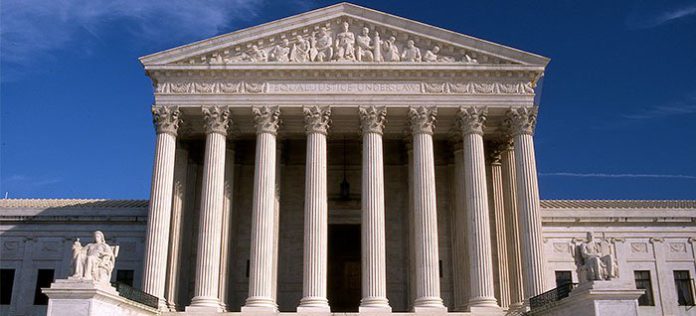
Although most patent counsel has been watching the patent case Oil States Energy Services v. Greene’s Energy Group, a U.S. Supreme Court decision in a lesser-known case now has companies scrambling to revisit their inter partes review strategy.
On April 24, the court held 7-2 in Oil States that inter partes review, a post-grant review process where the U.S. Patent and Trademark Office can affirm or extinguish patent claims, is indeed constitutional. The PTO can cancel patent rights despite the fact that its courts are not established by the Constitution because patent rights are public as opposed to private rights, the court found.
The same day, the court held 5-4 in SAS Institute Inc. v. Iancu that when the Patent Trial and Appeal Board institutes an IPR, it must decide on all of the patent claims the petitioner is challenging, contrary to how the board sometimes handled IPR challenges. The majority opinion hinged on a plain text reading of the IPR statute. While Oil States has proponents of IPR breathing a sigh of relief, SAS Institute has patentees bracing to re-mount a defense against patent claim challenges that could be revived from partial judgments.
“Oil States was the one everyone was worried about because if IPR had gone away, it would have been pandemonium,” said George Lewis, a partner at IP firm Merchant & Gould’s office in Denver. SAS Institute was “a sleeper case not a whole lot of people were watching,” he added.
Through the IPR process, a party can petition to have the PTAB review a patent’s claims for validity if the patent grant is at least nine months old. Parties often use IPRs as a less expensive means of challenging the validity of claims within a patent than taking them straight to federal court, and the board issues determinations within a year. In the initial years of IPR, petitioners enjoyed so much success extinguishing patent claims with it that Federal Circuit Chief Judge Randall Rader notoriously dubbed PTAB IPR panels as “death squads” for patents.
The decision in SAS Institute eliminated a dimension of IPR procedure that would result in “partial judgments.” When the PTAB accepted an IPR petition, it would sometimes decline to review one or more of the claims in the petition if it deemed the challenges to those claims were unlikely to succeed. After SAS Institute, the board can no longer make that “first cut” to weed out what it finds to be weaker challenges. The Supreme Court majority found that the statute gives the PTAB no wherewithal to do that, and instead compels the opposite.
“… [W]hen §318(a) says the Board’s final written decision ‘shall’ resolve the patentability of ‘any patent claim challenged by the petitioner,’ it means the Board must address every claim the petitioner has challenged,” wrote Justice Neil Gorsuch in the majority opinion.
John Posthumus, a shareholder at Polsinelli in Denver who does IP litigation and counseling, said there remains a large degree of uncertainty about how the PTAB will adjust the IPR process to comply with SAS Institute, at least on a case-by-case basis.
“There’s really a little bit of the Wild West in terms of what it’s going to look like,” Posthumus said.
Two days after the SAS Institute decision came down, the PTAB issued guidance on how it will apply the ruling. For IPRs where the board had trials pending but not on all of the claim challenges in the petition, it might sua sponte issue an order to call back the claims that it previously declined.
“That’s going to be a mess,” Lewis said. Cases that were closed might get reopened, and any patentees unlucky enough to have IPR cases pending right now might have to go back and dig up the uninitiated claims to defend against them, which would tack on unexpected legal costs, at a minimum. Petitioners who had claims that the PTAB didn’t initiate on “are going to be chomping at the bit to go get those claims back,” Lewis said.
The PTAB’s guidance on the decision appears to say that “all options are on the table” in terms of how the board will deal with pending IPR trials, Posthumus said. Where challenges get revived, the PTAB might allow extensions to accommodate additional discovery, briefing or argument. The PTAB might even reconsider a decision to institute a trial altogether, he said.
Going forward, the new “all-or-nothing” scheme might make IPRs even more attractive to accused infringers. The worst-case scenario for petitioners is to have a declined claim go to litigation, so they have both the IPR to commence and the surviving claim waiting to go to court afterward. Petitioners can be more confident that won’t happen now that they must get “a full yes or full no on the institution side,” Lewis said.
IP litigator Michael Dulin, who is a shareholder at Polsinelli in Denver, said the new IPR scheme following SAS Institute appears to “give the petitioner a little bit more control” at the outset. Instead of putting forth claims and letting the PTAB figure out which ones it will institute a trial on, petitioners will now have to be even more deliberate in their filings.
If a petitioner has a strong “rifle shot” of a challenge to a patent claim, one might still see the petitioner including less certain claims to the petition just to get them tied up in the IPR and out of court, Dulin said.
With more claims to adjudicate per IPR, the PTAB’s workload is sure to increase, and there are concerns as to how it will respond. Lewis wondered if the board might quietly raise the bar on the IPR petitions it will accept as a means of controlling its intake. If that happens, he said, the business community and patent bar won’t likely know for sure until statistics on IPR institution rates are released later.
— Doug Chartier

